#phalangeridae
Text

A spotted cuscus (Spilocuscus maculatus) in Raja Ampat, Indonesia
by Isabella Chowra
#spotted cuscus#cuscus#possums#marsupials#spilocuscus maculatus#spilocuscus#phalangeridae#diprotodontia#marsupialia#mammalia#chordata#wildlife: indonesia#wildlife: asia
305 notes
·
View notes
Text
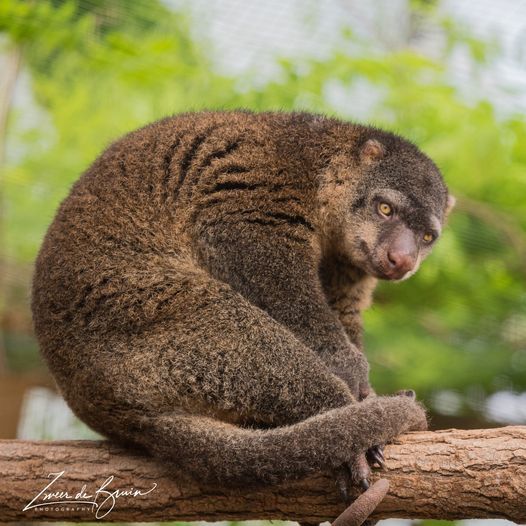
Sulawesi Bear Cuscus (Ailurops ursinus), family Phalangeridae, found in Sulawesi, Indonesia
Cuscuses are marsupials, related to Brush-tailed Possums.
photograph by Zweer de Bruin
158 notes
·
View notes
Text

White Cuscus
#white cuscus#common spotted cuscus#cuscus#Spilocuscus maculatus#Marsupialia#Diprotodontia#Phalangeridae#Spilocuscus#upl
15 notes
·
View notes
Text
#1839 - Trichosurus vulpecula hypoleucus - Western Brushtail Possum
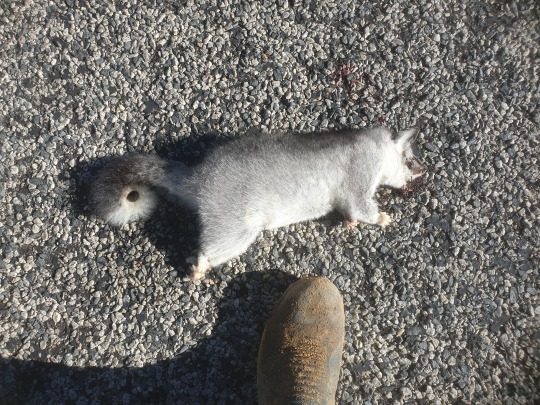
“Furry-tailed Little Fox, White Underneath”
This unfortunate roadkill was out on one of the country roads east of Perth, between two small patches of remnant bushland. Probably an adolescent - younger ones stay with the mother, and older ones are generally more cautious about traffic.
Brushtail Possums are native to Australia (including Tasmania) and some nearby islands, although they're a major pest in New Zealand, where they were introduced to provide a fur industry and on top of everything else are a host of bovine tuberculosis. They’re also a nuisance in suburban gardens, feasting on fruit trees, although their usual diet leans more towards eucalyptus leaves and anything they can catch.
They’re mostly nocturnal and come down to the ground more often than our other possums. There are six subspecies of the Common Brushtail, and colours may be silver-grey, brown, black, red, or cream. Although most will also have a reddish patch on the chest where the scent patch has stained the fur.
They vocalise with clicks, grunts, hisses, alarm chatters, guttural coughs, and screeching, which can be very annoying if they’re doing it in your roof.
3 notes
·
View notes
Note
That creature is a cuscus of the family phalangeridae, so the tag would be 'phalangerid'
thank you for your service comrade
2 notes
·
View notes
Photo

Waigeo cuscus (Spilocuscus papuensis)
Photo by Chien Lee
#waigeo cuscus#waigeo spotted cuscus#spilocuscus papuensis#spilocuscus#phalangerini#phalangerinae#phalangeridae#phalangeroidea#phalangeriformes#diprotodontia#metatheria#mammalia#tetrapoda
109 notes
·
View notes
Photo
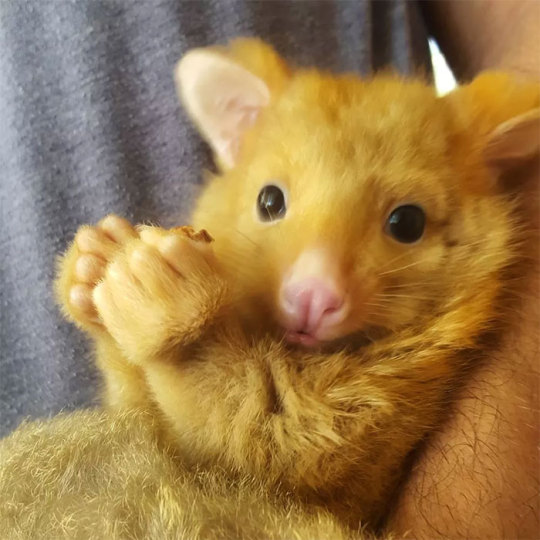
“GOLDEN” POSSUM
Color morph of the Brush Possum
Trichosurus vulpecula
©blacksnakeproductions
The common brushtail possum (Trichosurus vulpecula, from the Greek for "furry tailed" and the Latin for "little fox", previously in the genus Phalangista[4]) is a nocturnal, semi-arboreal marsupial of the family Phalangeridae, native to Australia, and the second-largest of the possums.
Like most possums, the common brushtail possum is nocturnal. It is mainly a folivore, but has been known to eat small mammals such as rats. In most Australian habitats, leaves of eucalyptus are a significant part of the diet, but rarely the sole item eaten. The tail is prehensile and naked on its lower underside. The four color variations are silver-grey, brown, black, and gold. The gold looks remarkably like Pikachu ;)
Another shot ©sreinisch

VIDEO:
Mama and baby Golden Possume here: https://www.youtube.com/watch?v=JTP201cG5zw
#brushtail possum#golden possum#pikachu#folivore#australia#animals#australia has all the cool animals#marsupial#Diprotodontia#phalangeridae#super cute
144 notes
·
View notes
Photo
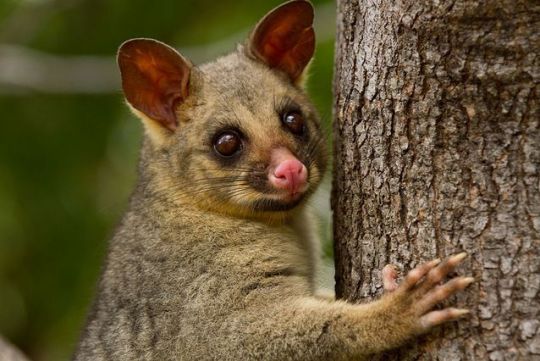
5 notes
·
View notes
Text

A Sulawesi bear cuscus (Ailurops ursinus) in Pairi Daiza Zoo, Belgium
by safi kok
#sulawesi bear cuscus#cuscus#possums#marsupials#ailurops ursinus#ailurops#Phalangeridae#diprotodontia#marsupialia#mammalia#chordata#captive animal#pairi daiza
109 notes
·
View notes
Note
What’s the difference between the possums in America and Australia
America doesn’t have possums, they have opossums which is an order called Didelphimorphia, while Australia has actual possums which are in the order Diprotodontia (that include roos, wombats, koalas) and in the suborder Phalangeridae.
Our possums look more like teddybears and opossums look like sewer rats on steroids.
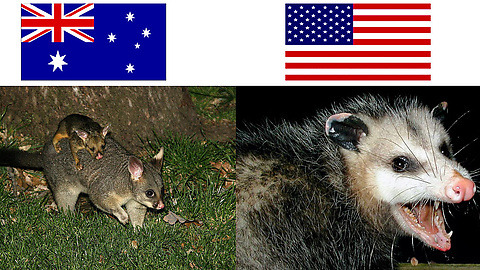
1K notes
·
View notes
Text
Anthro-Animal Universe: Large Anthros
This post focuses on how many varieties of the large anthros there might be in Anthro-Animal Universe. The mole-mice are already covered in another post, so they won’t be covered here.
I grouped similar animals together. The possums and opossums are grouped together. The bilbies and bandicoots are grouped with the rabbits, hares, and pikas. The quolls, Tasmanian devils, numbats, and thylacines are grouped with the Carnivora - since they’re all dog-like and/or cat-like in design. The hyraxes and wombats are grouped with Rodentia, due to similarity in design.
All are generous estimations, since all are rounded up.
Carnivora Group (including quolls, Tasmanian devils, numbats, thylacines; excluding bears, red pandas, coatis, raccoons, kinkajous, olingos, wolverines, skunks, seals, walruses): about 400 dog breeds, about 100 cat breeds, about 250 other species [about 750 varieties overall]
Rodentia Group (including hyraxes, wombats; excluding mice, voles, rats, gerbils, hamsters, lemmings, dormice, porcupines, birch mice, jumping mice, jerboas, spiny rats, naked mole rats, blesmols, kangaroo rats, porcupines, flying squirrels, beavers): about 100 hyrax subspecies, about 10 wombat species, about 700 species/subspecies [about 810 varieties overall]
Lagomorpha/Peramelemorphia Group (excluding New Guinean spiny bandicoots): about twenty Peramelemorphia species, about 100 Lagomorpha species [about 120 varieties overall]
Didelphimorphia/Diprotodontia Group (excluding fat-tailed mouse opossums, water opossums, woolly opossums, mouse opossums, gracile opossums, Chacoan pygmy opossums, Patagonian opossums, slender opossums, short-tailed opossums, gliders, bettongs, potoroos, rat-kangaroos, brushtail possums, kangaroos, wallabies, wallaroos, pygmy possums, honey possums, feather-tailed possums, wombats, koalas): about 30 Phalangeridae species, about 20 Petauridae species, about 25 Pseudocheiridae species, about 25 Didelphimorphia species [about 100 varieties overall]
That’s about 1800 large anthro varieties overall. While reproduction between the four groups is impossible, all reproduction is possible within the group. As such, there are plenty of dog-cat hybrids. Fur colours also range from shades of brown, shades of grey, or vibrant colours. So the possibilities are endless.
Overpopulation isn’t as big of an issue in that universe, as the anthro-animals have great regard for the environment. Even what we might think of as “big cities” are still surround by plenty of flora, and green energy (along with crystal energy) is used in place of fossil fuels.
There are about twenty times as much mole-mice as there are large anthros. Sapient birds and bats are each about a hundred times as populous as the large anthros. Horses are about 75% as populous as large anthros. Monkeys are about 80% as populous as large anthros. Non-monkey primates are about five times as populous as large anthros. Large bears are about twice as populous as large anthros, while raccoon-bears are about four times as populous as large anthros. Kangaroos, wallabies, and wallaroos are about half as populous as large anthros.
2 notes
·
View notes
Text
Cuscus
Scientific name
Phalanger Maculatus
Taxonomic classification
Kingdom: Animalia
Phylum: Chordata
Class: Mammalia
Order: Marsupialia
Family: Phalangeridae
Nutritional Requirement
Cuscus mainly eat fruit. leaves, and insects. Their favorite is fruit.
Growth and development
The Mothers have a small pouch on them which a baby stays in until they’re bigger. They usually stay for about 6 to 7 months.
Behavior
They are nocturnal and act like monkeys. They spend most of their life in trees.
Reproduction
Cuscus reproduce anytime of the year and are capable of making between 2 to 4 babies. The gestation period is just a couple of weeks.
Evolutionary origin
Cuscus are found to be closely related to the possum
Habitat
They live in Papa New Guinea in the forests.
2 notes
·
View notes
Text
Meet the sweet “Sugar Gliders”

The cute Petaurus breviceps has a big sweet tooth and surprising isn’t related to the flying squirrel.
Scientific name:
Petaurus breviceps
Taxonomic Classification:
Class: Mammalia
Infraclass: Marsupialia
Order: Diprotodontia
Suborder: Phalangerida
Family: Petauridae
Genus: Petaurus
Species: P. Breviceps
Nutritional Requirement:
“Sugar Gliders” eat anything that this sweet fresh fruits and vegetables are a big part of the Petaurus breviceps’ diet
Growth and development:
“Sugar Gliders” are marsupials, like most marsupial animals “Sugar Gliders” spend a very short time developing in the mother’s body before emerging at about the size of a grain of rice. After being born the Petaurus breviceps crawls into its mother's pouch and drinks her milk as it continues to develop.
Behavior:
The nocturnal “Sugar Gliders” are very social marsupials, in the wild “Sugar Gliders” will have nests with seven adults and their babies. Petaurus breviceps will huddle together in the cold and can also tell friends from foes with individual scent recognition of friends and family members.. The Petaurus breviceps.
Reproduction:
During the Winter and Spring months the Petaurus breviceps reproduction and produce a litter of two “Sugar Gliders” if normal. Young Petaurus breviceps spend seventy days in a pouch before being left in a nest.
Evolutionary Origins:
The Petaurus breviceps evolved from a rat-like ancestors and contrary to popular belief “Sugar Gliders” aren't related to flying squirrels.
Habitat:
In the wild “Sugar Gliders” live in up in trees around the northern and eastern parts of Australia, Tasmania, Papua New Guinea, and other associated isls. Because the Petaurus breviceps live high in the trees they often use their “wings” to glide from tree to tree
Fun Facts about the “Sugar Glider”:
“Sugar Gliders” can have many different types of fur from darker greys and browns to white!
“Sugar Gliders” make great pets and are hypoallergenic.
The Petaurus breviceps is extremely intelligent and has opposable thumbs.

My drawing of the Petaurus breviceps
Sources
http://www.parks.tas.gov.au/index.aspx?base=4883
http://evolution.berkeley.edu/evolibrary/article/analogy_02
http://www.sugargliderinfo.org/questions-and-answers.html
http://nhsugargliders.com/estore/glider-information/sugar-gliders-in-the-wild.html
http://sugargliders1012.weebly.com/evolution.html
2 notes
·
View notes
Photo

Spotted cuscus (Spilocuscus maculatus chrysorrhous)
Photo by Chien Lee
#spotted cuscus#spilocuscus maculatus chrysorrhous#spilocuscus maculatus#spilocuscus#phalangerini#phalangerinae#phalangeridae#phalangeroidea#phalangeriformes#diprotodontia#metatheria#mammalia#tetrapoda
29 notes
·
View notes
Text
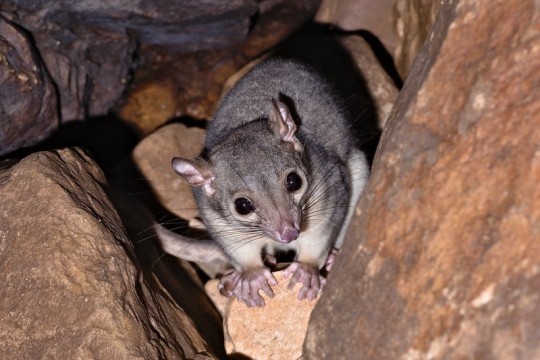
A scaly-tailed possum (Wyulda squamicaudata) in Kimberley, Australia
by Ian Bool
#scaly tailed possum#possums#marsupials#wyulda squamicaudata#wyulda#Phalangeridae#diprotodontia#marsupialia#mammalia#chordata#wildlife: australia#wildlife: oceania
140 notes
·
View notes
Text
Found a real Pikachu! (picture)
Found a real Pikachu! (picture)
[ad_1]
In Australia, the "Beka Mouse", which has acquired a bright yellow luster because of a genetic mutation, has been named Pikachu for the similarity between it and the most important person in the world's most famous pokemon game.
A resident of Melbourne, Victoria, found that the Pela or Phalangeridae (living in Australia and New Guinea) was lying motionless on the…
View On WordPress
0 notes